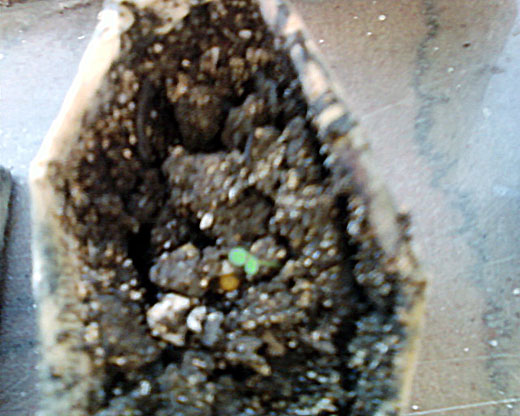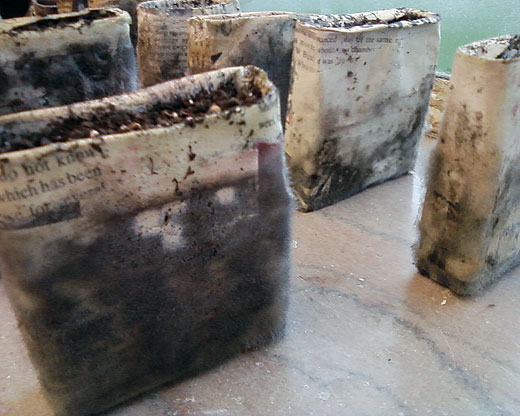Good news first!

A plant! In the planter! That’s what they’re there for! Hooray, plants! Hooray, exclamation points! Sorry about the blurry cameraphone picture! You’ll be grateful for that in a minute, however! Since the real action over the weekend wasn’t so much in the planters as… ehr… on them.

Now, plants are not really my forté, but I’m fairly certain that this is… not the desired effect.
Everything was fine when I checked in on things, Saturday. Nothing had dried out terribly, and I hardly added any new water. That nothing had dried out, with hindsight, should have been troubling in and of itself. I didn’t make it in yesterday, but this is what I encountered, today.
Mold isn’t really my forté, either (despite this apparent photographic evidence to the contrary), but I would guess the factors contributing to its… particular success, in this instance would have been these: (1) the planters were packed into a plastic tray quite tightly—this was clearly not the way to do things; (2) my studio has been a veritable sauna for some time, this weekend in particular; (3?) I wasn’t there for this round of planter construction, so I’m not sure if wheat-paste was involved, as it seemed to be in some iterations, but, if it was, I can see how that might have been a virtual signed invitation for any errant spores (and LeBel is teeming with them) to take up residence.
So there’s that. I’ve left them standing apart to dry out, but I’m not sure if that’s going to help much. I’m thinking perhaps it won’t?

Ahhhh… I’ve definitely seen mold before, and yes it makes a lot of sense that this happened, considering how tightly they were packed together. The mix does have flour in it (we ended up doing these something like paper maché), so that’s definitely where the mold comes from.
Do you have any time to catch up tomorrow, Steven?
My only ideas are to have them dry out a bit, try to put some salt on them to maybe kill the mold, and then keep brainstorming.
Okay, so I don’t have any tea tree oil or grapefruit seed extract, but I do have vinegar and a spray bottle?
Well, I suppose the question is, do you want your studio smelling like vinegar or Tea Tree Oil?
I’ll swing by Shoppers on my way to Lebel to pick up some Tea Tree Oil so we can potentially compare, and make this into a real science experiment!
Hah. Sounds like a plan. Still no grapefruit seed extract… I do have some orange juice from concentrate that’s been hanging around my fridge for the better part of a month…
Actually, I think we’ll be fine with the tea tree oil and vinegar, come to think of it.
it’s not really going to work though since there’s still paper on the inside. i seriously think it’s time to move on to something else. we can admit failure once in a while. better to put our energy into something else now.
kind of knew this would happen since we’re dealing with paper here. flour isn’t to blame though justin. just mix paper and water and humidity and you will get mold
Good to know the flour mix is still ok then.
ok but this is why i kept shaking my head in a way at this since i knew it would come to this. the main problem is humidity, aka summer. i saw leesa’s collection of books turn into a mold farm just from water, paper and humidity.
I definitely don’t think this project has to be considered a failure, though it certainly has been a very tough process. We’ve reworked this project a number of times, and I’m fairly certain that had these not been piled together in the plastic container, mold (on the outside at least) wouldn’t have come into play. And even mold on the inside isn’t going to stop the wildflowers from growing.
After all the work, it’d be a shame not to get these up.
I don’t know Justin. Last year at this time leesa had a fire at her storage space. Water got in. Anything in there that was made of paper grew mold in the humid environment. I spent many hours there cleaning and moving the things. On days when it was more humid, the smell was unbearable. On days when it was cooler, there was a huge difference.
I know it won’t stop the flowers from growing, but at this point I think it would be better to even start spreading the seeds in places that could use some life. With the seeds you have we could cover a lot more area than any planters we could distribute.
Given that the planters will be fairly widely distributed outdoors I don’t think the smell will be an issue. As well, although we could go and put the seeds in multiple places, I think that kind of misses the potential of the project in being a small (and now moldy) intervention into a surface of the city.
Whether or not these succeed as planters that facilitate the growth of huge bouquets of wildflowers is kind of beside the point, if they can suggest to someone a different way of thinking about where flowers belong in the city (to put it bluntly, maybe the project helps to ask a question about why flowers or vegetation of any kind is relegated to gardens or to flower beds or to city-controlled hanging planters).
Certainly though, yes, there are lots of other projects to tackle, and I think we’re definitely hitting the limits of what we can do with paper. However, there may be other materials to explore or other directions into which this project can go. I guess I just wonder if its too early to say that this project is over just yet.
That is such a shame… I’m sure once they go up and have proper air circulation, the mold growth will slow down.
Perhaps seed bombing is an option? just sprinkling seeds in places that they will grow. like in all the planters that the city hasn’t been taking care of becuase of the strike.
ALSO! if the seeds are just being tossed about, perhaps native plants should be used…
The Star has an article about native birds taking advantage of the long grass here http://bit.ly/DPrP8 Maybe native flowers would help them out even more?
I definitely do not think this project is a failure. I think we should keep going, figuring out how to combat these problems (which I do not think are major enough to consider them failures, mold is natural, mold is penicilin, we can cure Windsor with antibiotic planters woo!)
I would still like to go forward with them, it is a great project and has recieved considerable inquiries.